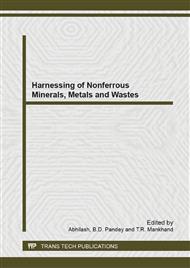p.1
p.11
p.21
p.33
p.45
p.55
p.65
p.73
Optimization Studies on Flocculant Aided Filtration of Very-Fine Grained Alkaline Leach Slurry Using Central Composite Rotatable Design
Abstract:
This paper discusses filtration behavior of very-fine grained alkaline leach slurry containing dissolved uranyl carbonate using commercial flocculants and dewatering surfactants. Evaluation of the best combination of flocculant and surfactant was made on the basis of capillary suction time (CST) data. Addition of INDFLOC 477 and CTAB to the alkaline leach slurry reduced the CST to 17 seconds from a very high level of 177 seconds obtained without the addition of any filtration aids. Detailed optimization of critical parameters like dosages and temperature of filtration were carried out on INDFLOC 477 and CTAB reagent combine adopting central composite rotatable design of experimentation to obtain maximum rate of filtration with minimum cake moisture. The studies indicated scope of achieving filtration rate of about 695 kg/h.m2 with 23% cake moisture upon addition of 167 g/t of INDFLOC 477 and CTAB at filtration temperature of 600 C.
Info:
Periodical:
Pages:
21-32
Citation:
Online since:
November 2013
Authors:
Keywords:
Price:
Сopyright:
© 2014 Trans Tech Publications Ltd. All Rights Reserved
Share:
Citation:


